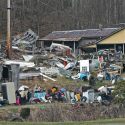Deep beneath the Earth lies a mysterious and powerful force. A wellspring of nuclear energy which could one day rip us apart. Many scientists have found clues that natural nuclear reactions have occurred in the past. But should we be worried?
Could the Earth’s core explode anytime soon? What would happen if it did? How could we prevent it?
In 1972, 15 natural fission reactors were discovered in a mine in West Africa. Scientists found uranium samples with isotope structures matching those found in modern nuclear reactors. If you’re fishin’ for an explanation, well, nuclear fission is when a larger atom is split into two new, smaller atoms. Each time this split happens, energy is released. But where does all this energy go?
In a study from 2011, scientists theorized any movement of the Earth’s continents and crust could actually be due to nuclear fission. It just so happens Earth is chock full of radioactive elements, including uranium, thorium and potassium. Scientists believe that over the billions of years of Earth’s existence, radioactive isotopes have been splitting, releasing energetic particles known as antineutrinos. By measuring these antineutrino emissions, they discovered roughly 20 terawatts of the Earth’s heat is a result of geo-reactions. That’s enough energy to move mountains. Literally and forcibly.
So does this mean we might be sitting on a ticking time bomb?
Believe it or not, there may have been a massive geo-reaction in the past. After analyzing lunar rocks, scientists found silicate from the Earth and the Moon show a striking similarity. This could suggest that our Moon may have been formed from the Earth’s mantle. This is just a theory, but it might help us understand what’s happening beneath the Earth’s mantle to cause such explosions.
In order for a natural nuclear reactor to occur, there needs to be a high enough concentration of U-235, an isotope of uranium, the presence of water or graphite to slow down neutrons, and little to no presence of neutron absorbing elements, such as silver. At the KamLAND detector, an underground facility near Toyama, Japan, scientists can measure antineutrinos passing through the Earth as a result of radioactive decay.
If there’s an abnormally high quantity, this could be a useful warning sign of an impending geo-reaction. We could also look at computer simulations to help us find areas where these natural reactors might occur and measure them with antineutrino counters. Or, we might just notice something strange happening in the ground.
Certain areas may fluctuate between being hot and cold or emit steam at weird intervals. If we detect it, we’d need to find a way to prevent it. A geo-reaction could tear the whole Earth apart, and possibly create a second moon, if we’re not careful!
One thing we could do is pump a whole lot of silver or cobalt into suspect areas, which would help absorb the neutrons and stop any reaction with element U-235. Though we’d better hope the geo-reactor isn’t too deep for us to reach, otherwise, we may need to figure out another, more complex, plan.
Luckily, scientists believe the amount of element U-235 is too low at around 0.72% for any of this to occur any time soon. Thank goodness! As awesome as having a second moon might be, we likely wouldn’t survive to see it. Unless, of course, we preemptively set up shop on our current Moon in some kind of celestial lunar city.
Subscribe to What-If on YouTube or follow the show on Facebook Watch.
Sources
- ” What Is Uranium? How Does It Work – World Nuclear Association “. 2020. world-nuclear.org.
- “Why is the earth’s core so hot? And how do scientists measure its temperature?”. Scientific American.
- “What Keeps the Earth Cooking?”. 2011. News Center.
- “Nature’s Nuclear Reactors: The 2-Billion-Year-Old Natural Fission Reactors In Gabon, Western Africa”. Mervine, Evelyn. 2011. Scientific American Blog Network.
- “Earth’s First Nuclear Reactor Is 1.7 Billion Years Old And Was Made Naturally”. Siegel, Ethan. 2020. Forbes.
- “Are there nuclear reactors at Earth’s core?”. Ball, Philip. 2008. Nature.
- “Nuclear Power Today | Nuclear Energy – World Nuclear Association “. 2020. world-nuclear.rg.



























